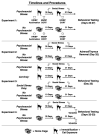Acute episodes of predator exposure in conjunction with chronic social instability as an animal model of post-traumatic stress disorder
- PMID: 18574787
- PMCID: PMC2535807
- DOI: 10.1080/10253890701768613
Acute episodes of predator exposure in conjunction with chronic social instability as an animal model of post-traumatic stress disorder
Abstract
People who are exposed to horrific, life-threatening experiences are at risk for developing post-traumatic stress disorder (PTSD). Some of the symptoms of PTSD include persistent anxiety, exaggerated startle, cognitive impairments and increased sensitivity to yohimbine, an alpha(2)-adrenergic receptor antagonist. We have taken into account the conditions known to induce PTSD, as well as factors responsible for long-term maintenance of the disorder, to develop an animal model of PTSD. Adult male Sprague-Dawley rats were administered a total of 31 days of psychosocial stress, composed of acute and chronic components. The acute component was a 1-h stress session (immobilization during cat exposure), which occurred on Days 1 and 11. The chronic component was that on all 31 days the rats were given unstable housing conditions. We found that psychosocially stressed rats had reduced growth rate, reduced thymus weight, increased adrenal gland weight, increased anxiety, an exaggerated startle response, cognitive impairments, greater cardiovascular and corticosterone reactivity to an acute stressor and heightened responsivity to yohimbine. This work demonstrates the effectiveness of acute inescapable episodes of predator exposure administered in conjunction with daily social instability as an animal model of PTSD.
Figures









Similar articles
-
Psychosocial predator-based animal model of PTSD produces physiological and behavioral sequelae and a traumatic memory four months following stress onset.Physiol Behav. 2015 Aug 1;147:183-92. doi: 10.1016/j.physbeh.2015.04.032. Epub 2015 Apr 22. Physiol Behav. 2015. PMID: 25911267
-
Differential effectiveness of tianeptine, clonidine and amitriptyline in blocking traumatic memory expression, anxiety and hypertension in an animal model of PTSD.Prog Neuropsychopharmacol Biol Psychiatry. 2013 Jul 1;44:1-16. doi: 10.1016/j.pnpbp.2013.01.001. Epub 2013 Jan 12. Prog Neuropsychopharmacol Biol Psychiatry. 2013. PMID: 23318688
-
Influence of daily social stimulation on behavioral and physiological outcomes in an animal model of PTSD.Brain Behav. 2016 Apr 15;6(5):e00458. doi: 10.1002/brb3.458. eCollection 2016 May. Brain Behav. 2016. PMID: 27110436 Free PMC article.
-
Early post-stressor intervention with high-dose corticosterone attenuates posttraumatic stress response in an animal model of posttraumatic stress disorder.Biol Psychiatry. 2008 Oct 15;64(8):708-717. doi: 10.1016/j.biopsych.2008.05.025. Epub 2008 Jul 17. Biol Psychiatry. 2008. PMID: 18635156
-
Predator-based psychosocial stress animal model of PTSD: Preclinical assessment of traumatic stress at cognitive, hormonal, pharmacological, cardiovascular and epigenetic levels of analysis.Exp Neurol. 2016 Oct;284(Pt B):211-219. doi: 10.1016/j.expneurol.2016.06.003. Epub 2016 Jun 6. Exp Neurol. 2016. PMID: 27283115 Review.
Cited by
-
Animal models of post-traumatic stress disorder: face validity.Front Neurosci. 2013 May 31;7:89. doi: 10.3389/fnins.2013.00089. eCollection 2013. Front Neurosci. 2013. PMID: 23754973 Free PMC article.
-
Biological studies of post-traumatic stress disorder.Nat Rev Neurosci. 2012 Nov;13(11):769-87. doi: 10.1038/nrn3339. Epub 2012 Oct 10. Nat Rev Neurosci. 2012. PMID: 23047775 Free PMC article. Review.
-
Combining stressors that individually impede long-term memory blocks all memory processes.PLoS One. 2013 Nov 6;8(11):e79561. doi: 10.1371/journal.pone.0079561. eCollection 2013. PLoS One. 2013. PMID: 24223180 Free PMC article.
-
Principles for developing animal models of military PTSD.Eur J Psychotraumatol. 2014 Aug 14;5. doi: 10.3402/ejpt.v5.23825. eCollection 2014. Eur J Psychotraumatol. 2014. PMID: 25206946 Free PMC article.
-
Experimental Post-traumatic Stress Disorder Decreases Astrocyte Density and Changes Astrocytic Polarity in the CA1 Hippocampus of Male Rats.Neurochem Res. 2016 Apr;41(4):892-904. doi: 10.1007/s11064-015-1770-3. Epub 2015 Nov 17. Neurochem Res. 2016. PMID: 26577396
References
-
- Adamec R. Transmitter systems involved in neural plasticity underlying increased anxiety and defense—implications for understanding anxiety following traumatic stress. Neurosci Biobehav Rev. 1997;21:755–765. - PubMed
-
- Adamec RE, Shallow T. Lasting effects on rodent anxiety of a single exposure to a cat. Physiol Behav. 1993;54:101–109. - PubMed
-
- Adamec RE, Burton P, Shallow T, Budgell J. NMDA receptors mediate lasting increases in anxiety-like behavior produced by the stress of predator exposure: Implications for anxiety associated with posttraumatic stress disorder. Physiol Behav. 1999;65:723–737. - PubMed
-
- Adamec RE, Blundell J, Burton P. Relationship of the predatory attack experience to neural plasticity, pCREB expression and neuroendocrine response. Neurosci Biobehav Rev. 2006;30:356–375. - PubMed
-
- Adamec R, Muir C, Grimes M, Pearcey K. Involvement of noradrenergic and corticoid receptors in the consolidation of the lasting anxiogenic effects of predator stress. Behav Brain Res. 2007;179:192–207. - PubMed
Publication types
MeSH terms
Substances
Grants and funding
LinkOut - more resources
Full Text Sources
Medical
Miscellaneous
